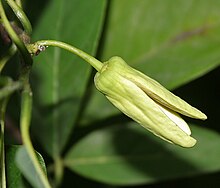Cinnamon apple
| Cinnamon apple | ||||||||||||
|---|---|---|---|---|---|---|---|---|---|---|---|---|

Cinnamon apple ( Annona squamosa ), illustration |
||||||||||||
| Systematics | ||||||||||||
|
||||||||||||
| Scientific name | ||||||||||||
| Annona squamosa | ||||||||||||
| L. |
The cinnamon apple , custard apple or Süßsack ( Annona squamosa ) is a tropical tree art from the family of annonaceous (Annonaceae). The species comes from tropical America and is cultivated in numerous varieties in the tropics and subtropics because of its tasty fruits .
description
Vegetative characteristics
The cinnamon apple is a shrub or tree up to 6 meters high with a spreading crown. The bark is light brown, smooth or slightly cracked. The leaves are alternate and arranged in two rows. The petiole becomes 5 to 15 millimeters long and is slightly hairy. The tough leaf blade is eilanzettlich, 5 to 17 inches long, 2 to 5.5 inches wide and entire. The leaf base is broadly wedge-shaped to rounded, the leaf end pointed or blunt. The top is dull green, the underside is lighter and hairy down. The leaves are largely thrown off in the dry season. Grated leaves smell aromatic.
blossoms
The flowers stand individually on young twigs or in groups of up to four flowers opposite the leaves. They are stalked about an inch long and are fragrant. Three petals each stand in two rows. The inner ones are only rudimentary and scale-shaped. The outer ones are elliptical to obtuse eilanzettlich, 3 inches long and 0.8 inches wide. They are fleshy, slightly hairy, greenish-yellow in color and reddish on the inside at the base. The stamens are club-shaped, and with 1 to 3 millimeters about the same length as the inner petals. The stamps are available when you open the flower to several tubular together and grow together later. The flowers are pollinated by beetles.
Fruits and seeds
When fruits plump, indented in the approach of the stem are collecting berries formed. They reach a diameter of 5 to 10 centimeters. The fruit is green, yellow-green, or purple in color when ripe, and is often frosted. It is composed of strongly arched, egg-shaped scales that easily separate from each other when ripe. The flesh is creamy white and when ripe it is soft and has a juicy, pulpy, fine grainy consistency with a sweet taste. The numerous, glossy black-brown seeds are about 1.5 inches long and 0.6 inches wide and flattened ovoid. There are also varieties that do not produce seeds.
Chromosome number
The number of chromosomes is 2n = 14 or 18.
Distribution and ecology
The cinnamon apple comes from tropical America, but its original range is unknown. It is one of the most popular fruit trees in tropical and subtropical areas worldwide. To the north, the growing areas extend to Florida, Egypt and China.
The species grows in tropical and subtropical climates in areas with high levels of precipitation and changing humidity. It needs sufficient water in the growth phase, but can also survive long dry periods without leaves.
Systematics and research history
The cinnamon apple ( Annona squamosa ) is a species from the genus Annona in the family of the Annonaceae . The species was described by Carl von Linné in his work Species Plantarum in 1753 . A synonym of the species is Annona asiatica L.
The name of the genus Annona was first used by Francisco Hernandez de Toledo and probably goes back to the word "anon" for the Taíno language . The specific epithet squamosa comes from Latin and means "scaly". It describes the scaly fruits of the species.
use
The fruits of the cinnamon apple are among the tastiest fruits in the tropics. For consumption, the ripe fruits are broken open and eaten out of hand or spooned without peel or seeds. The pulp is also made into ice or mixed with water used as a drink. However, the kernels of the seeds are poisonous and cause intestinal problems. Unchewed, swallowed seeds with an intact shell are harmless. Poultices made from the leaves are used to treat wounds and ulcers, but also against epilepsy . The leafy stock is digestive and is also used for rheumatism baths and for lowering fever. The unripe fruits, the leaves and the bark are used against diarrheal diseases. The seed powder is used as an insecticide.
Adult trees can bear 20 to 50 fruits a year. Since the flowers are only open for fertilization for a few hours, the yield can be increased through artificial fertilization, which can raise the yield per tree to 100 fruits.
Individual evidence
- ↑ a b c Bernd Nowak, Bettina Schulz: Pocket dictionary of tropical useful plants and their fruits . Quelle & Meyer, Wiebelsheim 2009, ISBN 978-3-494-01455-5 , p. 57 .
- ↑ a b Annona squamosa. In: Flora of North America Vol. 3. www.eFloras.org, accessed February 15, 2011 .
- ↑ a b c d e Nowak et al .: Pocket dictionary of tropical crops and their fruits , p. 58
- ^ Annona squamosa at Tropicos.org. In: IPCN Chromosome Reports . Missouri Botanical Garden, St. Louis
- ↑ Annona squamosa. In: Germplasm Resources Information Network (GRIN). United States Department of Agriculture, accessed February 15, 2011 .
- ↑ Helmut Genaust: Etymological dictionary of botanical plant names. 3rd, completely revised and expanded edition. Nikol, Hamburg 2005, ISBN 3-937872-16-7 , pp. 64-65 (reprint from 1996).
- ↑ Exactly: Etymological Dictionary of Botanical Plant Names , p. 607
- ↑ a b Nowak et al .: Pocket dictionary of tropical crops and their fruits , p. 59
- ↑ Annona squamosa. In: Flora of Pakistan. www.eFloras.org, p. 11 , accessed on February 15, 2011 (English).



